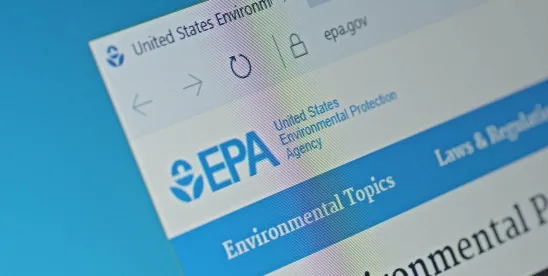The Trump Administration has proposed implementing a broad range of regulatory changes in order to promote the development of artificial intelligence (AI) in the United States.
Here, we discuss the environmental implications of the White House’s proposed plans on various industrial sectors, including electric power generation and transmission, data centers, and semiconductor manufacturing.
America’s AI Action Plan
On July 23, the White House released “Winning the Race: America’s AI Action Plan,” in accordance with President Trump’s January 23 executive order (EO), “Removing Barriers to American Leadership in Artificial Intelligence.” The Plan details a number of policy actions the Trump Administration intends to implement over the next few years, emphasizing the Administration’s goal to “innovate faster and more comprehensively than our competitors in the development and distribution of new AI technology across every field, and dismantle unnecessary regulatory barriers that hinder the private sector in doing so.” If implemented, the Plan will have broad reaching consequences for many different sectors.
Of the three pillars of the Plan, Pillar II in particular calls for an overhaul of America’s physical and digital infrastructure to reduce the burdens of environmental permitting and other regulations on building infrastructure to meet demand for AI. The Plan sets out several recommendations focused on data center construction, grid modernization, and increased semiconductor manufacturing, including:
- Creating new categorical exclusions under the National Environmental Policy Act for routine data center-related construction.
- Exploring the need for a nationwide Clean Water Act (CWA) Section 404 permits for data centers to ameliorate pre-construction delays.
- Streamlining, permitting, or reducing regulations under the CWA, Clean Air Act (CAA), and Comprehensive Environmental Response, Compensation, and Liability Act.
- Directing agencies with significant available federal lands to identify sites suited for large-scale construction of data centers and associated power generation infrastructure.
EPA Proposed Regulatory Changes
On the same day, President Trump also released multiple EOs and corresponding fact sheets, including an EO titled “Accelerating Federal Permitting of Data Center Infrastructure.” This order, among other things, directs agencies like the US Environmental Protection Agency (EPA) to undertake various actions aimed at accomplishing the AI Action Plan’s recommendations.
EPA, accordingly, is considering regulatory changes to facilitate the development of AI. EPA Administrator Lee Zeldin has stated that “EPA remains committed to bolstering President Trump’s efforts by streamlining permitting and cutting heavy handed regulations to ensure America can build and power the data centers essential to Making America the AI Capital of the World.” The Agency has also particularly touted its desire to undertake permitting reform to help ensure that the United States has the necessary electrical supply to power AI development by boosting the construction and use of power plants and other facilities. In a Fox News op-ed, Administrator Zeldin recently highlighted several potential policy changes, including the following:
- Increasing certainty about what kind of permits are needed for new and modified projects. This could include updating EPA’s rule defining “applicable requirements,” which determines what must be included in a CAA Title V air operating permit. It could also include updating EPA’s Actual-to-Projected-Actual Implementation Policy, which defines how permit applicants should estimate the emissions impacts of modifications to emission sources, which helps determine the applicability of the CAA’s New Source Review (NSR) program.
- Updating EPA’s Reactivation Policy, which guides the Agency’s decisions concerning whether a shuttered plant is considered “new” or “modified” if it restarts. Administrator Zeldin has expressed a desire to allow power producers to restart plants with a lower chance of triggering NSR permitting requirements.
- Limiting or reversing CAA public participation requirements applicable to NSR for minor sources.
- Redefining EPA’s policy on when facilities “begin actual construction” to require a company to obtain an NSR permit only when the company actually breaks ground, and to allow project developers to take certain preparatory steps without having to wait for the permit.
Takeaways
Some of these proposed changes may be implemented through guidance, while others will have to go through the full rulemaking process under the Administrative Procedure Act and will necessarily take longer to implement. But, in general, the Administration appears to be planning a comprehensive review of ways to reduce timing restraints and permitting burdens on ramping up power generation to support AI.





 />i
/>i

